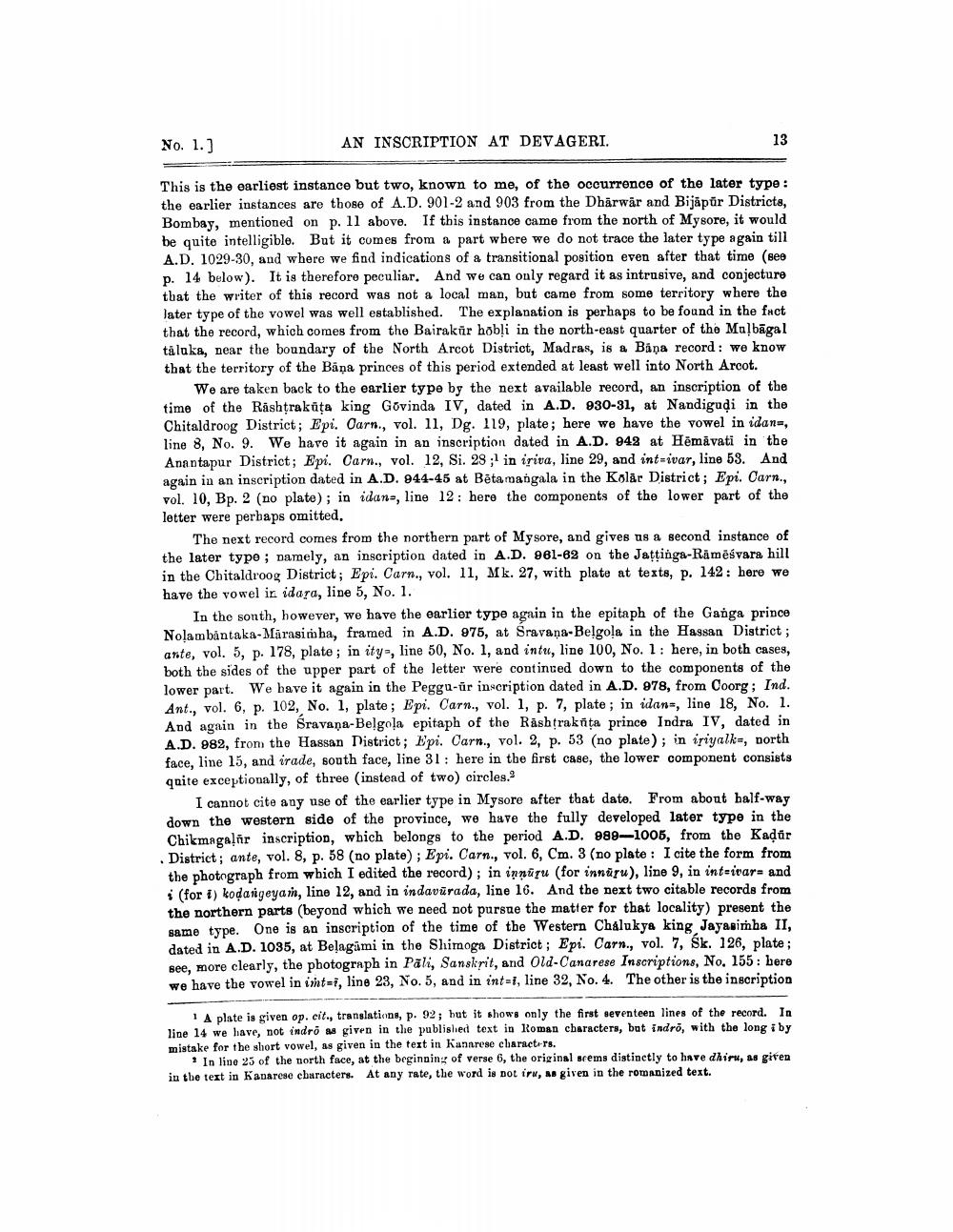________________
AN INSCRIPTION AT DEVAGERI.
13
No. 1.]
This is the earliest instance but two, known to me, of the occurrence of the later type: the earlier instances are those of A.D. 901-2 and 903 from the Dharwar and Bijapur Districts, Bombay, mentioned on p. 11 above. If this instance came from the north of Mysore, it would be quite intelligible. But it comes from a part where we do not trace the later type again till A.D. 1029-30, and where we find indications of a transitional position even after that time (see p. 14 below). It is therefore peculiar. And we can only regard it as intrusive, and conjecture that the writer of this record was not a local man, but came from some territory where the later type of the vowel was well established. The explanation is perhaps to be found in the fact that the record, which comes from the Bairakur höbli in the north-east quarter of the Mulbagal taluka, near the boundary of the North Arcot District, Madras, is a Bana record: we know that the territory of the Bana princes of this period extended at least well into North Arcot.
We are taken back to the earlier type by the next available record, an inscription of the time of the Rashtrakuta king Govinda IV, dated in A.D. 930-31, at Nandiguḍi in the Chitaldroog District; Epi. Carn., vol. 11, Dg. 119, plate; here we have the vowel in idan=, line 8, No. 9. We have it again in an inscription dated in A.D. 942 at Hemavati in the Anantapur District; Epi. Carn., vol. 12, Si. 28;1 in iriva, line 29, and int-ivar, line 53. And again in an inscription dated in A.D. 944-45 at Bêtamangala in the Kolar District; Epi. Carn., vol. 10, Bp. 2 (no plate); in idan-, line 12: here the components of the lower part of the letter were perhaps omitted.
The next record comes from the northern part of Mysore, and gives us a second instance of the later type; namely, an inscription dated in A.D. 961-62 on the Jaṭṭinga-Rāmēsvara hill in the Chitaldroog District; Epi. Carn., vol. 11, Mk. 27, with plate at texts, p. 142: here we have the vowel in idara, line 5, No. 1.
In the south, however, we have the earlier type again in the epitaph of the Ganga prince Nolambántaka-Marasimha, framed in A.D. 975, at Sravana-Belgola in the Hassan District; ante, vol. 5, p. 178, plate; in ity-, line 50, No. 1, and intu, line 100, No. 1: here, in both cases, both the sides of the upper part of the letter were continued down to the components of the lower part. We have it again in the Peggu-ür inscription dated in A.D. 978, from Coorg; Ind. Ant., vol. 6, p. 102, No. 1, plate; Epi. Carn., vol. 1, p. 7, plate; in idan, line 18, No. 1. And again in the Sravana-Belgola epitaph of the Rashtrakñṭa prince Indra IV, dated in A.D. 982, from the Hassan District; Epi. Carn., vol. 2, p. 53 (no plate); in iriyalk=, north face, line 15, and irade, south face, line 31: here in the first case, the lower component consists quite exceptionally, of three (instead of two) circles.2
I cannot cite any use of the earlier type in Mysore after that date. From about half-way down the western side of the province, we have the fully developed later type in the Chikmagalur inscription, which belongs to the period A.D. 989-1005, from the Kaḍür . District; ante, vol. 8, p. 58 (no plate); Epi. Carn., vol. 6, Cm. 3 (no plate: I cite the form from the photograph from which I edited the record); in innuru (for innuru), line 9, in intivar and i (for i) koḍangeyam, line 12, and in indavurada, line 16. And the next two citable records from the northern parts (beyond which we need not pursue the matter for that locality) present the same type. One is an inscription of the time of the Western Chalukya king Jayasimha II, dated in A.D. 1035, at Belagami in the Shimoga District; Epi. Carn., vol. 7, Sk. 126, plate; see, more clearly, the photograph in Pali, Sanskrit, and Old-Canarese Inscriptions, No. 155: here we have the vowel in imti, line 23, No. 5, and in int-i, line 32, No. 4. The other is the inscription
1 A plate is given op. cit., translations, p. 92; hut it shows only the first seventeen lines of the record. In line 14 we have, not indro as given in the published text in Roman characters, but indro, with the long i by mistake for the short vowel, as given in the text in Kanarese characters.
In line 25 of the north face, at the beginning of verse 6, the original seems distinctly to have dhiru, as given in the text in Kanarese characters. At any rate, the word is not iru, as given in the romanized text.




